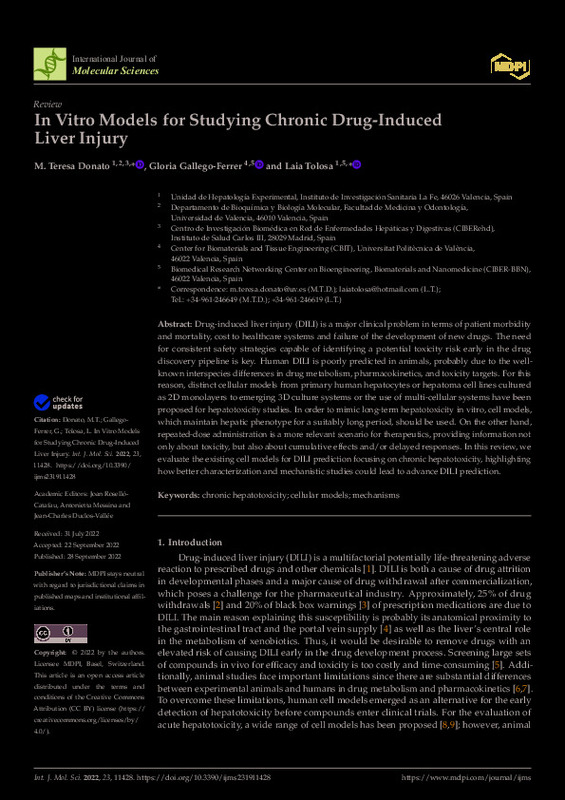JavaScript is disabled for your browser. Some features of this site may not work without it.
Buscar en RiuNet
Listar
Mi cuenta
Estadísticas
Ayuda RiuNet
Admin. UPV
In Vitro Models for Studying Chronic Drug-Induced Liver Injury
Mostrar el registro sencillo del ítem
Ficheros en el ítem
| dc.contributor.author | Donato, M. Teresa
|
es_ES |
| dc.contributor.author | Gallego-Ferrer, Gloria
|
es_ES |
| dc.contributor.author | Tolosa, Laia
|
es_ES |
| dc.date.accessioned | 2023-05-25T18:01:30Z | |
| dc.date.available | 2023-05-25T18:01:30Z | |
| dc.date.issued | 2022-10 | es_ES |
| dc.identifier.uri | http://hdl.handle.net/10251/193614 | |
| dc.description.abstract | [EN] Drug-induced liver injury (DILI) is a major clinical problem in terms of patient morbidity and mortality, cost to healthcare systems and failure of the development of new drugs. The need for consistent safety strategies capable of identifying a potential toxicity risk early in the drug discovery pipeline is key. Human DILI is poorly predicted in animals, probably due to the well-known interspecies differences in drug metabolism, pharmacokinetics, and toxicity targets. For this reason, distinct cellular models from primary human hepatocytes or hepatoma cell lines cultured as 2D monolayers to emerging 3D culture systems or the use of multi-cellular systems have been proposed for hepatotoxicity studies. In order to mimic long-term hepatotoxicity in vitro, cell models, which maintain hepatic phenotype for a suitably long period, should be used. On the other hand, repeated-dose administration is a more relevant scenario for therapeutics, providing information not only about toxicity, but also about cumulative effects and/or delayed responses. In this review, we evaluate the existing cell models for DILI prediction focusing on chronic hepatotoxicity, highlighting how better characterization and mechanistic studies could lead to advance DILI prediction. | es_ES |
| dc.description.sponsorship | This work has been supported by the Institute of Health Carlos III (ISCIII, Plan Estatal de I+D+i 2013-2016) and co-financed by the European Regional Development Fund "A way to achieve Europe" (FEDER) through grant PI21/00223, by the Spanish Ministry of Science and Innovation Ministry-Spanish Research Agency through the Project PID2019-106000RB-C22/AEI/10.13039/501100011033, and by the Generalitat Valenciana (PROMETEO/2019/060). | es_ES |
| dc.language | Inglés | es_ES |
| dc.publisher | MDPI AG | es_ES |
| dc.relation.ispartof | International Journal of Molecular Sciences | es_ES |
| dc.rights | Reconocimiento (by) | es_ES |
| dc.subject | Chronic hepatotoxicity | es_ES |
| dc.subject | Cellular models | es_ES |
| dc.subject | Mechanisms | es_ES |
| dc.subject.classification | MAQUINAS Y MOTORES TERMICOS | es_ES |
| dc.title | In Vitro Models for Studying Chronic Drug-Induced Liver Injury | es_ES |
| dc.type | Artículo | es_ES |
| dc.identifier.doi | 10.3390/ijms231911428 | es_ES |
| dc.relation.projectID | info:eu-repo/grantAgreement/AEI/Plan Estatal de Investigación Científica y Técnica y de Innovación 2017-2020/PID2019-106000RB-C22/ES/MODELOS INNOVADORES DE CELULAS HEPATICAS HUMANAS EN 3D PARA LA PREDICCION MECANISTICA DEL DAÑO HEPATICO INDUCIDO POR FARMACOS/ | es_ES |
| dc.relation.projectID | info:eu-repo/grantAgreement/AEI//PID2019-106000RB-C21//HIDROGELES BIOMIMETICOS IMPRIMIBLES CON PRESENTACION DE FACTORES DE CRECIMIENTO EFICIENTE PARA ESTUDIOS DE HEPATOTOXICIDAD DE ALTO RENDIMIENTO/ | es_ES |
| dc.relation.projectID | info:eu-repo/grantAgreement/ISCIII/Plan Estatal de Investigación Científica y Técnica y de Innovación 2017-2020 (ISCIII)/PI21%2F00223/ES/NUEVAS TECNOLOGIAS TRASLACIONALES PARA EL TRATAMIENTO DE ENFERMEDADES HEPATICAS: PREACONDICIONAMIENTO DEL HIGADO, NUEVAS FUENTES CELULARES Y BIOMATERIALES EN TERAPIA CELULAR/ | es_ES |
| dc.rights.accessRights | Abierto | es_ES |
| dc.contributor.affiliation | Universitat Politècnica de València. Escuela Técnica Superior de Ingenieros Industriales - Escola Tècnica Superior d'Enginyers Industrials | es_ES |
| dc.description.bibliographicCitation | Donato, MT.; Gallego-Ferrer, G.; Tolosa, L. (2022). In Vitro Models for Studying Chronic Drug-Induced Liver Injury. International Journal of Molecular Sciences. 23(19):1-30. https://doi.org/10.3390/ijms231911428 | es_ES |
| dc.description.accrualMethod | S | es_ES |
| dc.relation.publisherversion | https://doi.org/10.3390/ijms231911428 | es_ES |
| dc.description.upvformatpinicio | 1 | es_ES |
| dc.description.upvformatpfin | 30 | es_ES |
| dc.type.version | info:eu-repo/semantics/publishedVersion | es_ES |
| dc.description.volume | 23 | es_ES |
| dc.description.issue | 19 | es_ES |
| dc.identifier.eissn | 1422-0067 | es_ES |
| dc.identifier.pmid | 36232728 | es_ES |
| dc.identifier.pmcid | PMC9569683 | es_ES |
| dc.relation.pasarela | S\486632 | es_ES |
| dc.contributor.funder | Instituto de Salud Carlos III | es_ES |
| dc.contributor.funder | AGENCIA ESTATAL DE INVESTIGACION | es_ES |
| dc.contributor.funder | Agencia Estatal de Investigación | es_ES |
| dc.contributor.funder | European Regional Development Fund | es_ES |








